Top 10 Patterns from Lewis Smith
Tactics that worked for both spotted and largemouth bass in Alabama
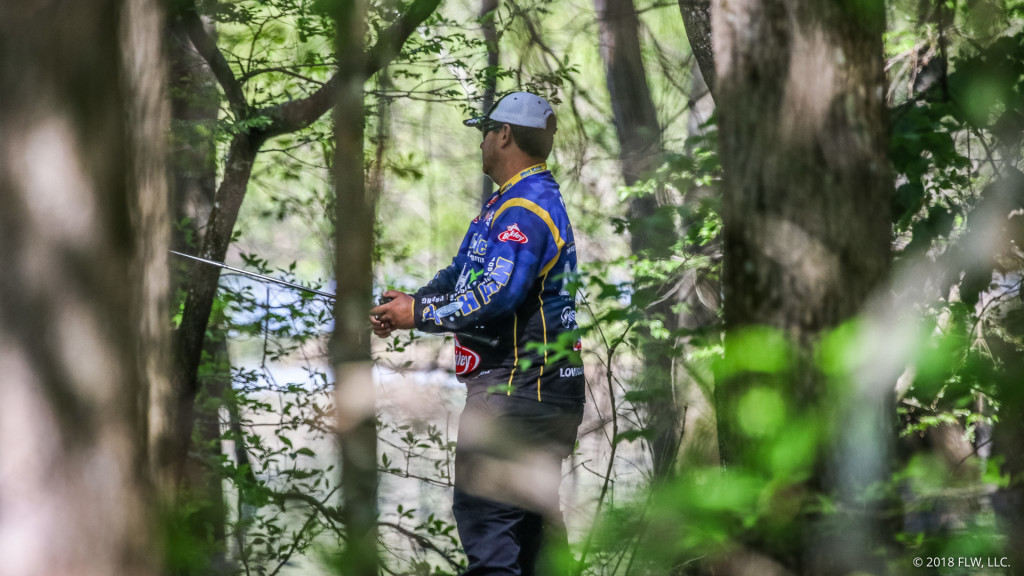
Lewis Smith is a great spotted bass fishery, but if last week’s FLW Tour event presented by T-H Marine confirmed anything it’s that you’ll probably need some largemouths to go with the spots if you’re going to win there.
No one pulled this off better than David Williams, who focused on skipping a swim jig under docks to capitalize on the shad spawn en route to winning the tournament. Nearly everyone behind him tried to follow suit, albeit with a multitude of patterns.
One other thing worth noting is that while Lewis Smith has three major arms – the Ryan, Rock and Sipsey – the entire top 10 fished either the Rock or Ryan, or some mixture of both.
Here’s how the top 10 navigated a flooded fishery with multiple species in play.
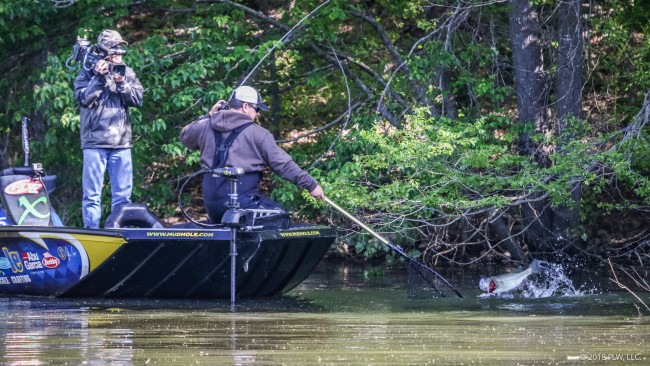
2. Cox comes up just short on redemption
Every angler has one tournament he feels he should’ve won. For John Cox, it was the 2015 Lewis Smith event.
Three years ago, Cox was on a solid shallow pattern in flooded cover far up Ryan Creek, but on the final day he was thrown from his boat on his run to his spot and was unable to finish the day.
Cox came into this season’s Lewis Smith event thinking the high water would once again set up perfectly for him to catch some giant largemouths in the flooded trees and bushes up Ryan. Problem is, the water was actually too high and muddy.
“There was just too much cover, and the fish were so far back in it you couldn’t get to them,” says the pro from Debary, Fla.
Instead of being stubborn, Cox utilized a similar pattern in the backs of creeks off the main lake in the first 10 miles of both Ryan and Rock creeks. He’d work his way down the bank flipping and swimming a black-and-blue 1/2-ounce Dirty Jigs Swim Jig with a Berkley PowerBait MaxScent Meaty Chunk trailer. In the process, he’d also occasionally stumble on a bed fish or skip a dock with a wacky-rigged Berkley PowerBait MaxScent The General worm.
However, late on day three Cox noticed the water had dropped enough to pull the fish toward the edges of the flooded cover. Once he saw that, he knew he’d spend the final day working those outer fringes.
The plan looked like it might come together early, as he sacked up 15 pounds in the first 100 yards of cover he fished with the swim jig, but the bite completely died after that.
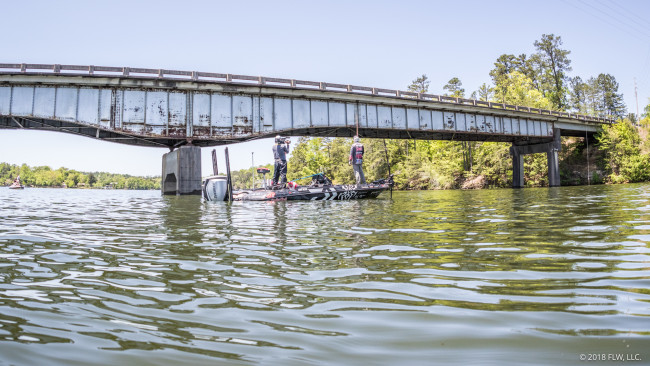
3. Meyer right at home with “random” spot bite
Cody Meyer is one of the best spotted bass fishermen in the country, having learned the trade back home in California. Oddly enough, the spotted bass fisheries in California were actually stocked with spots from Lewis Smith Lake. So it’s little wonder why Meyer felt right at home all week.
“Seriously, this is a blast,” says the Auburn, Calif., angler. “I’ve had so much fun this week.”
Meyer ran a “random” pattern, sometimes stopping on a point or row of docks that he hadn’t fished in practice or previously in the event.
“I’m so comfortable fishing randomly,” Meyer says. “I’d just see a point someone didn’t hit or a stretch I thought should hold fish, and I’d stop and fish it. That’s what you have to do to be successful back home, and it’s the same here.”
Two distinct patterns did emerge from the chaos, though. The first was fishing bridge pilings, which Meyer tapped into on day one on a bridge up Ryan Creek. By the final day, he was running all four major bridges in the fishery to try and capitalize on a typical holding area for postspawn spotted bass. He’d make casts as close to the pilings as possible with a wacky-rigged Strike King Ocho in ghost minnow, letting it flutter down right next to the piling to suspended fish.
The other pattern was a dock pattern, but not just the docks.
“The dock cables,” Meyer says. “It’s so weird, but they’ll actually suspend under the dock cables in the front of docks. Most guys miss that.”
Meyer again utilized the stick bait, as well as a Strike King Rage Swimmer on a 1/4-ounce Owner ball-head jig to tap into his dock-cable deal.
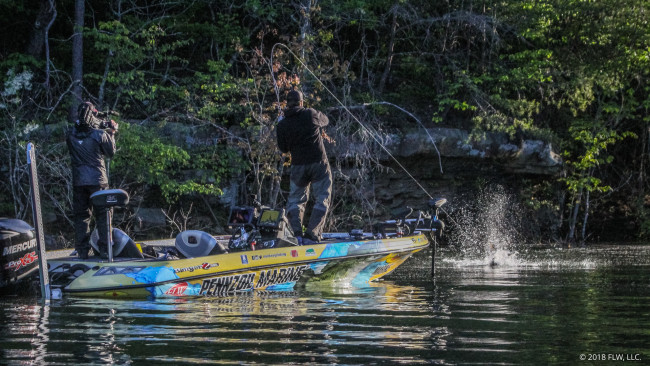
4. Arey runs various patterns throughout derby
Matt Arey is known as a pattern fisherman, and technically he was running patterns this week. It’s just that his pattern seemed to change by the day.
The Shelby, N.C., pro came into the tournament hoping to sight-fish some and supplement with a deep dock pattern for spots and a shallow swimbait pattern for largemouths. On day one all three worked out. He plucked some bed fish early and then ran more than 25 places in both Ryan and Rock creeks to beef up his bag. However, he ended up leaning on one pattern or another the rest of the way, with bed fish playing the smallest role of all by tournament’s end.
Arey’s dock pattern proved the most consistent. He focused on any dock with some sort of bottom contour beneath it and would catch 11 to 12 pounds of spotted bass a day pretty quickly from his dock milk run before chasing largemouths. The greater the contour, the better the fish seemed to hang under the dock above it. To catch his fish, he skipped a wacky-rigged stick bait with a 7-foot, medium-light Okuma Helios rod and Okuma RTX reel.
Meanwhile, his shallow largemouth pattern was more random. Arey picked various creeks and cuts he felt might have cruising prespawn and postspawn largemouths that might be interested in his Lunkerhunt Fetch swimbait. The key was having a little extra wind blowing into the areas, or else the bass would more often follow the swimbait instead of eat it. He threw the Fetch on a 7-foot, 6-inch Okuma Scott Martin TCS rod, Okuma Helios TCS reel and 17-pound-test P-Line Tactical Fluorocarbon.
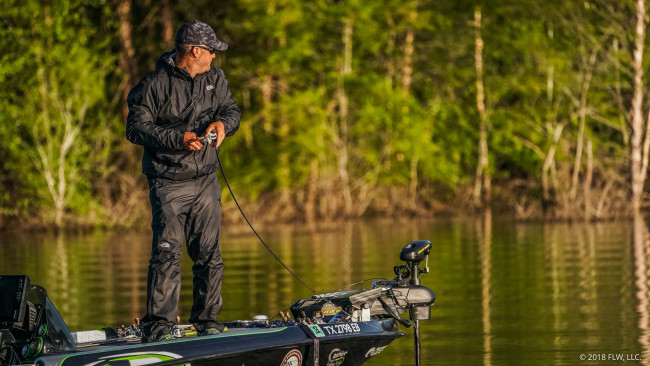
5. Osborne finds “crazy” area
It’s rare to find one of those spots where fish are just stacked up and chomping every cast, and even rarer to find it in a tournament. Yet, that’s exactly what Jordan Osborne uncovered this week.
The spot was a roughly 60-foot section of transitional flat in the back of a creek arm far up Ryan Creek. With the lake level up, there was 7 feet of water over the top of it, with the sweet spot being the original bank line.
“It was a crazy deal,” the Longview, Texas, pro says. “I think the spotted bass were trying to spawn there, but then I think the largemouths were coming out and staging there. So I had fish coming to me from all directions.”
All four mornings Osborne was able to catch keepers seemingly at will on a Ned rig, shaky head, Keitech 3.8 Swing Impact FAT and vibrating jig, but the bite got tougher on the weekend.
When his spot died after 45 minutes on Saturday he fell back to flipping trash mats in the backs of coves with a Missile Baits D Bomb in bruiser flash color behind a 1/2-ounce weight. Osborne ended up catching two good ones but also missing six.
Osborne returned to his main area Sunday morning. While there were still some numbers there, the quality had decreased. After that he did some flipping and also tossed a frog.
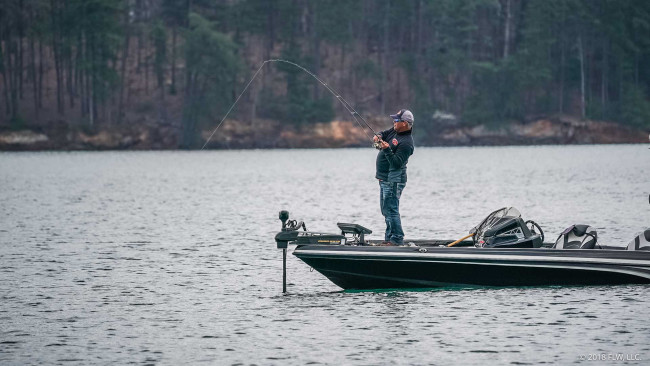
6. Reyes sticks it out with a swimbait
After finishing 25th at Lake Lanier, Reyes came into this event with a singular focus and tool: He was going to fish for spotted bass, and he was going to do it solely with a swimbait.
“I just dedicated myself to it because I know they’ll eat it if you throw it enough,” says Reyes. “I caught some suspended in drains and some off docks. It was painfully slow. I might only get six bites a day, but they were good bites.”
Reyes did locate one key stretch of water up Ryan Creek where he could catch a few quickly to start his day, and he usually was able to upgrade later.
He fished a Keitech 3.8 Swing Impact FAT on a homemade jighead by casting it out, counting it down and then reeling as slow as he possibly could.
“Sometimes I’d pause it to try and get a reaction bite,” says Reyes, who now has a pair of top 10s on Lewis Smith. “I just pushed and trusted it for four days.”
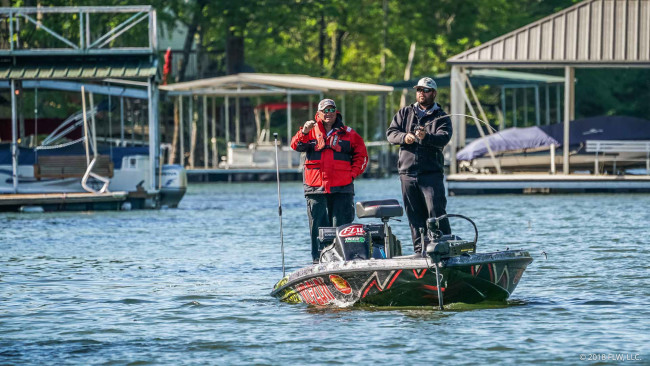
7. Davis makes back-to-back top 10s
Clent Davis has now made back-to-back top-10 finishes in two very different ways.
At Cumberland he targeted smallmouths on points with a swimbait. Back in his home state at Lewis Smith, Davis focused on one thing and one thing only: the dock pattern.
“That’s all I fished all four days,” Davis says. “My practice was basically useless, but I figured out the dock bite on day one and just rode it.”
In the cloudy conditions on day one Davis was able to get some quality bites on a swimbait, but once the sun came out on day two he switched to a Ned rig with a Mister Twister Poc’it Fry on a Nichols Lures Clent’s Toadstool Jighead. He’d pitch it around the docks and simply let it fall. Suspended bass grabbed it on the way down.
“I’ve been very fortunate these last few events,” Davis adds. “I just have to keep it rolling.”
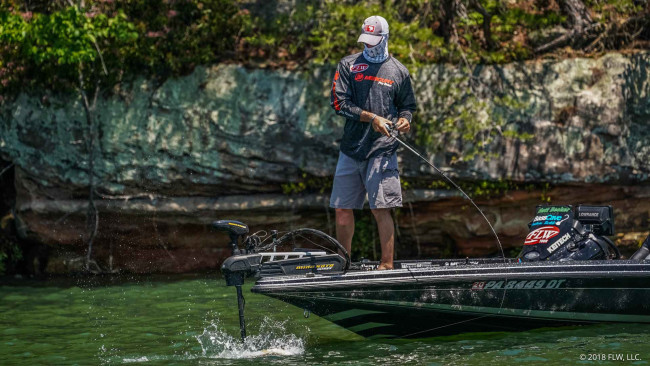
8. Becker mirrors Thrift
“Watch the video of what Bryan Thrift was doing at Cumberland,” Matt Becker says. “That’s exactly what I was doing [at Smith].”
While not 100 percent accurate, Becker had the general idea.
The Finleyville, Pa., pro worked his swimbait by casting it out, letting it sink down and then slowly reeling it back. The difference was his targets. At Cumberland, Thrift targeted smallmouths staging along steep banks and points.
“I was fishing for schoolers that weren’t schooling,” Becker says. “Basically, they were schools of spotted bass that were suspended out over channel swings. They were classic schooling spots, only the fish weren’t schooling. So I had to try and get that swimbait down and bump one in the head to get it to bite.”
Becker did weigh in a couple fish throughout the event that he caught when they did actually come up schooling, but most of the fish were the suspended, inactive variety. The schools were suspended 10 to 20 feet down over anywhere from 60 to 100 feet.
Becker got keyed in on the pattern by accident, as he admits he was lost in practice and the majority of day one. Then around 3 p.m. he found one of those schools and tossed a Keitech 3.8 Swing Impact FAT on a 1/4-ounce Bass Cave Tackle Dead Head Screwlock head at them almost out of frustration. Once he was able to coax a few to bite he simply expanded from there.
“I don’t have a lot of experience on spotted bass, but I’m starting to love them,” Becker adds.
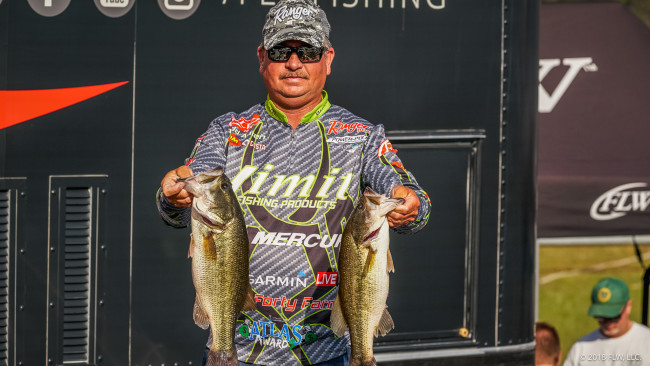
9. Auten also on shad-spawn pattern
Todd Auten and David Williams have been competing against one another back in the Carolinas for more than 20 years. So it’s little surprise they fish similarly and ended up keyed on the shad-spawn bite at Smith.
“In practice, I caught fish off five docks in a row,” Auten says. “I didn’t see any shad, but when I didn’t get bit on the docks above or below them I kind of thought that [the shad spawn] was what was happening. Then the first morning of the tournament I went back to those docks and jacked them.”
Auten’s main area was in Crooked Creek, where he skipped a white homemade vibrating jig with a Zoom Salty Super Fluke trailer.
Unfortunately, while Williams was able to expand on his pattern in two other areas, Auten never managed to break out from Crooked Creek.
“I knew my pattern was going away in my area, and one other area I thought might be good I went into and David was already there,” Auten says.
He “just went fishing” in some other areas and eventually found some schoolers that helped a little.
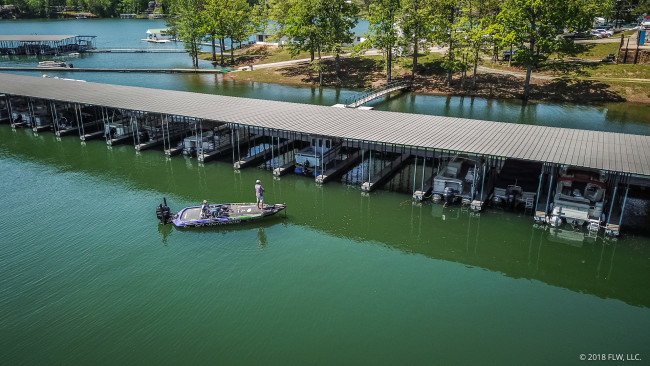
10. Reese keys on docks, topwater bite
Similar to his California counterpart Cody Meyer, Jimmy Reese was all in on the dock bite … at least for the first two days.
Reese did a lot of damage skipping either a Yamamoto California Roll or Yamamoto Kut Tail Worm on a Frenzy Baits Nail Shakey Head, or swimming a swim jig with a Yamamoto Heart Tail Shad Swimbait up under docks.
However, Mother Nature keyed him into a new pattern on day three.
“The third day there was so much dew on my boat in the morning I knew they would chew topwater to start,” Reese says. “I caught one early, and then every time I went to put it down I caught another. They just kept eating it. I kept the topwater in my hand all the way until 1 p.m.”
The topwater of choice was either a Boing Lure or Heddon Super Spook, which he’d fish parallel down the bank, specifically banks with any sort of depth change and bushes.